Introduction: The Importance of DIY Car Maintenance
Performing your own car maintenance and repairs can be incredibly rewarding. Not only does it save you money compared to taking your car to a mechanic, but it also allows you to learn more about your vehicle and gain a sense of accomplishment from fixing it yourself.
However, without the proper tools, DIY car maintenance can be difficult, dangerous, or even impossible. Investing in quality power tools tailored for automotive work makes car repairs and upkeep much more accessible for the average car owner.
This article will explore twenty of the most essential power tools for DIY car maintenance and repairs. For each tool, we’ll discuss its importance and how it can be used to make you a more self-sufficient car owner. We’ll also provide tips for using these tools safely and properly.
Arm yourself with these essential car power tools, and you’ll be able to perform basic maintenance, diagnose problems, and even undertake more advanced repairs on your own. Let’s get started!
Understanding the Basics of Car Maintenance
Before diving into the power tools themselves, it’s helpful to understand the basics of routine car maintenance. Performing regular maintenance is the best way to extend the life of your car, optimize its performance, identify issues early, and prevent breakdowns.
Here are some of the most common DIY car maintenance tasks:
- Oil changes – Changing the engine oil and filter every 3,000-5,000 miles helps remove contaminants and prevent sludge buildup.
- Air filter replacement – A dirty air filter can reduce engine power. Replacing it annually prevents reduced fuel economy.
- Fluid checks and fills – Topping off fluids like transmission, brake, power steering, and coolant keeps systems operating properly.
- Tire rotation – Rotating tires every 5,000-8,000 miles helps them wear evenly and extend their life.
- Tire pressure checks – Underinflated tires wear faster and negatively impact handling and fuel economy.
- Battery testing – A car battery typically lasts 3-5 years. Test annually and replace if necessary.
- Spark plug replacement – Spark plugs eventually wear out after 30,000-100,000 miles, negatively impacting performance.
- Brake pad replacement – Worn brake pads reduce braking power. They typically need replacement every 20,000-70,000 miles.
Performing basic maintenance like this will go a long way towards keeping your car in good working order and preventing major repairs down the road. Now let’s look at the tools that make these jobs possible for the DIY mechanic.
The Role of Power Tools in Car Maintenance
Many car repairs or maintenance tasks require significant physical effort, such as loosening stubborn bolts or nuts. Other jobs need specialized capabilities beyond just simple hand tools. This is where power tools come in.
Power tools provide the brute strength, torque, speed, and other mechanical advantages necessary to perform many automotive jobs efficiently, safely, and accurately. While skilled mechanics employ specialized high-end tools, DIYers can tackle most common tasks with affordable consumer-grade power tools.
Cordless battery power tools offer the ultimate in convenience and mobility, allowing you to bring the power source right to the car. However, corded electric tools generally provide greater sustained power for extended use.
The following sections will highlight twenty of the most useful power tools for DIY work on cars and light trucks. Consider adding these gadgets to your automotive toolkit to make car repairs and maintenance a breeze.
Safety First: Precautions When Using Power Tools
While power tools make DIY car jobs easier and faster, they can also be dangerous if not used correctly. Here are some key safety tips to keep in mind when using power tools for automotive work:
- Wear safety goggles to protect your eyes from flying debris. Also wear gloves, close-toed shoes, and ear protection as needed.
- Make sure you use the right size and type of tool for the job. Improper tool use can lead to injuries and damage.
- Before use, inspect tools for damage and undue wear. Repair or replace damaged power tools.
- Operate tools at their intended speed setting for the job. Excess speed can be dangerous.
- When not in use, unplug corded tools and switch off battery tools so they cannot start accidentally.
- Avoid awkward hand positions that make the tool difficult to control. Maintain proper grip and footing.
- Ensure bits and blades are securely installed in the tool before operation.
- Keep flammable solvents and fuels away from power tools to prevent fire risk.
By following basic safety practices like these, you can harness the utility of power tools while avoiding hazards. Now let’s check out the top twenty power tools for empowering your DIY auto work!
Essential Power Tool #1: Impact Wrench
An impact wrench (or impactor) is an air-powered or electric tool that delivers high torque output in short bursts. The hammering action allows it to efficiently loosen even very tight or rusted bolts and nuts.
This makes an impact wrench invaluable when:
- Changing tires – Removing lug nuts and bolts holding the wheel
- Removing bolts on mechanical parts during disassembly
- Loosening stuck bolts and fasteners that cannot be broken free with hand tools
Cordless impact wrenches offer maximum convenience, while corded models provide greater sustained power for really stubborn hardware.
Why an Impact Wrench is a Must-Have for Car Repairs
Here are some key reasons why an impact wrench is an essential addition to any DIY mechanic’s tool kit:
- Saves time – An impact wrench removes bolts in seconds that could take minutes with hand tools alone. This drastically speeds up repairs.
- Prevents stripped hardware – The hammering action is effective at loosening stuck bolts without damaging or rounding them off like hand tools can.
- Allows proper torque – Most impact wrenches have variable speed triggers, allowing you to match the torque output to the job. Applying proper torque prevents overtightening or undertightening hardware.
- Reduces physical effort – The power tool does the hard work, reducing strain on your arms, wrists, and hands during repairs.
- Long-lasting – Good quality impact wrenches provide years of reliable service with minimal maintenance required.
- Affordable – Electric and air-powered impact wrenches are available at reasonable costs, even for limited DIY use.
So if you find yourself struggling with stuck, overtightened fasteners during automotive work, an impact wrench is sure to make your life easier. It’s one of the handiest power tools for both major car repairs and routine maintenance.
Essential Power Tool #2: Cordless Drill
A cordless drill is right up there with the hammer and screwdriver as one of the most universally useful power tools. The portable drilling and driving capabilities open up a world of possibilities for DIY repairs.

A cordless drill allows driving screws in tight spaces
Here are some of the many uses for a cordless drill in auto maintenance and repair:
- Installing and removing screws, including in hard-to-access areas
- Drilling holes through metal, plastic, and other materials
- Removing damaged screws using left-handed drill bits
- Polishing and buffing using attachments and wire brush bits
- Mixing fluid in a bucket using a paddle attachment
Many cordless drills also include variable speed triggers and clutches allowing control over torque and RPMs. This versatility makes them useful for everything from delicate tasks to driving large lag bolts.
The Versatility of a Cordless Drill in Car Maintenance
It’s difficult to overstate the usefulness of a cordless drill for DIY car repairs and maintenance. Here are some of the factors that make it such a versatile power tool:
- Compact size – The handheld drill can access tight engine spaces that larger tools cannot. Lightweight models are easy to maneuver into awkward positions.
- Interchangeable bits – Switching between screwdriver bits, drill bits, wire brushes, polishing pads, and more allows different jobs with the same tool.
- Variable speed – Slow speeds prevent damage to electronics or small parts. Higher speeds drill metal and drive large screws. The trigger gives real-time speed control.
- Clutch setting – This limits torque to prevent over-tightening fasteners or stripping screw heads. A must when working on sensitive components.
- Cordless convenience – No tangled power cords. Most models have lithium-ion batteries offering extended runtime between charges.
- Affordable price – Even homeowners who only occasionally work on cars can justify purchasing a basic cordless drill at a reasonable cost.
For any task that requires boring, driving, tightening, loosening, or detail work, a cordless drill should be the DIYer’s first choice for powerful, precise, and convenient performance.
Essential Power Tool #3: Angle Grinder
With the ability to grind, cut, polish, sand, and sharpen, an angle grinder is a remarkably useful addition to the DIY mechanic’s toolbox. The compact size and rotational grinding action allow accessing tight areas and quickly removing material.

An angle grinder makes quick work of cutting metal
Angle grinders are commonly used for:
- Cutting seized bolts to disassemble components
- Grinding welds during panel replacement and rust repair
- Sanding and polishing paint and body work
- Sharpening tools like chisels that become dull over time
They require careful handling, as the grinding discs rotate at 10,000+ RPM. But used properly, this versatile tool can save huge amounts of time and effort.
How an Angle Grinder Can Assist in Car Repairs
Here are some of the biggest benefits an angle grinder provides for DIY auto repairs:
- Quick cutting – Easily and smoothly cuts through metal parts like exhaust components, bolts, and welds far faster than hacksaws or sawzalls.
- Rust removal – Quickly strips rust from panels and components with wire cup brushes to get down to clean metal.
- Stuck fastener removal – When bolts break orcannot be removed, an angle grinder can cut them off for fast disassembly.
- Weld grinding – Efficiently removes excess material from welds to achieve a smoother finish. Essential for structural rust repair.
- Detailing uses – Grinding attachments smooth imperfections in body filler and buff paint to a brilliant shine.
- Compact size – Fits where larger grinders cannot reach to perform precision work in tight areas.
While it requires skill to use safely, an angle grinder greatly expands the home mechanic’s capabilities for cutting, grinding, sanding, sharpening, and more.
Essential Power Tool #4: Air Compressor
An air compressor opens up a world of pneumatic tools that run off compressed air. These include air ratchets, impact wrenches, spray guns, inflators, and other handy gadgets. But the versatile air compressor has many direct uses as well.

An air compressor has many uses beyond powering tools
Handy automotive jobs for a small air compressor include:
- Inflating tires – Essential for maintaining proper tire pressures
- Cleaning parts – Blow out dirt and debris from tight areas
- Atomizer – Sprays small amounts of fluids like lubricants
- Air brush – For delicate paint, touch up, and detailing work
- Powering air tools – Impact wrench, die grinder, ratchet, etc.
- Refrigerant recharging – Some A/C service procedures
Portable electric compressors offer the flexibility for DIY use, while gas-powered models provide higher airflow for extended pneumatic tool use.
The Importance of an Air Compressor in Tyre Maintenance
Maintaining proper tyre pressure is critical for safe handling, fuel economy, and tread life. An air compressor provides several benefits for tyre maintenance:
- Anytime inflation – Compressors allow refilling tyres from home rather than searching for an air pump. Helpful if a slow leak is detected at inopportune times.
- Precision filling – Dial in precise pressures for optimum inflation rather than relying on a service station’s imprecise air hoses.
- Inflator attachments – Built-in tire chucks make getting accurate pressure a snap without wrestling separate hoses and inflation needles.
- Portability – Small compressors can easily be transported in the vehicle for on-the-road fill-ups when needed.
- Efficiency – Air compressors top off a tyre faster than manual pumping could. This saves significant time when refilling multiple tyres.
- Cost savings – Avoid coins-operated service station compressors and nitrogen refill fees by filling your own tyres.
Whether performing a tyre rotation or addressing slow air leaks, an air compressor empowers DIYers to keep their tyres inflated properly. Given the huge impact of tyre maintenance on safety and car life, this tool is a must-have.
Essential Power Tool #5: Car Polisher
A car polisher or buffer uses a rotating buffing pad to polish paint and apply wax or sealant. This achieves a brilliant, swirl-free shine that no amount of hand work can match.
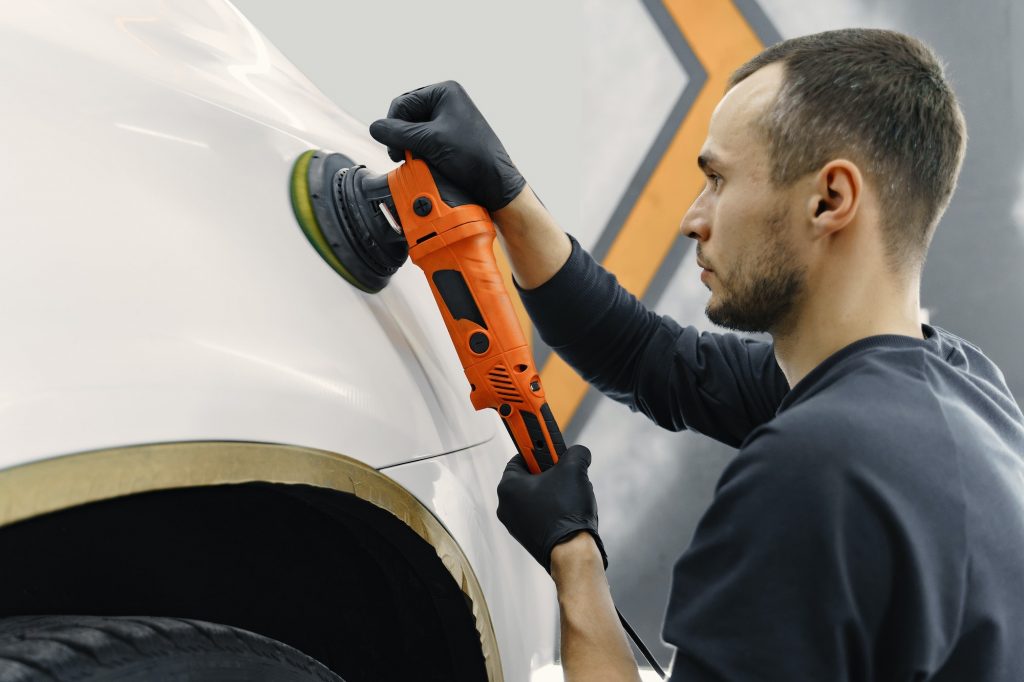
Here are some detailing jobs made possible by a car polisher:
- Removing light swirls and scratches from clear coat
- Applying wax smoothly and evenly over the entire surface
- Buffing out polishing compound once scratches are removed
- Applying paint sealants that bond to the clear coat for protection
- Buffing off old wax in preparation for applying fresh coats
Variable speed settings allow matching the RPMs to the buffing pad size and job at hand. Slow speeds are used with heavier polishing compounds, while higher speeds finish the detail with a fine polish.
Achieving a Professional Finish with a Car Polisher
While polishing by hand can remove some blemishes in the clear coat, a car polisher provides major benefits:
- Faster polishing – A buffer can polish an entire vehicle in a fraction of the time of manual work. This saves hours of labor.
- Better cleaning – The rotational action cleans more thoroughly, removing swirls, water spots, oxidation, and fine scratches missed by hand work.
- More shine – High-speed buffing leaves behind an incredibly smooth, glossy, mirror-like shine unmatched by hand polishing.
- Effortless waxing – The buffing pad evenly spreads wax over the entire surface and buffs it crystal clear with no streaks or missed spots.
- Consistent pressure – A steady buffing motion is easier to maintain compared to tiring, uneven hand work. This prevents paint damage.
- Pro-level results – Restores showroom shine that looks professionally detailed without paying for expensive detailing services.
With the ability to thoroughly clean painted surfaces and create an incredible glossy finish, a buffer is the detailing enthusiast’s secret weapon.
Essential Power Tool #6: Battery Charger
Every car needs a functioning battery to start and run properly. A battery charger allows DIY testing, charging, and maintenance to keep the battery in top shape.

Important uses for an automotive battery charger include:
- Slow charging a dead or weak battery to revive it
- Quick charging before a trip if time is limited
- Testing battery and electrical system health
- Diagnosing whether a battery needs replacement
- Keeping batteries from being drained by accessories
- Desulfating to restore charge capacity in older batteries
Advanced chargers even allow programming custom charge curves optimized for the battery type and condition.
Keeping Your Car Battery Healthy with a Battery Charger
A dedicated automotive battery charger has features making it invaluable for maintaining battery health:
- Portability – Lightweight chargers can easily be moved outside to access the battery. No need to push the car into the garage to charge.
- Automatic shutoff – Prevents overcharging once the battery is fully charged. No risk of damage.
- Diagnostics – Test battery state of charge and health to determine if replacement is needed.
- Desulfation – Remove harmful lead sulfate deposits to restore lost battery capacity on older units. Prolongs battery life.
- Onboard charging – Maintains the battery at optimal charge without running the engine if a car sits unused for weeks.
- Safety features – Protect against reverse polarity, short circuits, overvoltage, overcharging, and overheating during charging.
While often overlooked, keeping a trickle charger handy is essential for monitoring battery health and preventing being stranded by a dead battery. It’s one of the most basic but vital tools for DIY maintenance.
Essential Power Tool #7: Work Light
Good lighting is important when working under the hood or beneath the car, where shadows can hide problems or make repairs difficult. A portable work light provides high-intensity illumination wherever needed.

Handy uses for automotive work lights include:
- Lighting dark corners of the engine bay during maintenance
- Illuminating underneath the car when repairing the underside or suspension
- Portable light source when working at night or with limited garage lighting
- Lighting interior sections while installing audio equipment or accessories
The Importance of Good Lighting in Car Maintenance
Quality lighting serves several purposes during DIY car repairs:
- Inspection – Bright, white light reveals problems like leaks, cracked hoses, and damaged wiring hidden in shadows.
- Accuracy – The ability to clearly see the components prevents missteps like stripped bolts or detached connectors.
- Safety – A well-lit workspace reduces the likelihood of injuries from slipping or unseen protruding parts.
- Convenience – Less time straining to peer into dark recesses translates to less frustrated effort during repairs.
- Portability – Cordless work lights can be positioned optimally without relying on fixed garage lighting of limited intensity.
- Affordability – Inexpensive work lights are available in a range of sizes and power levels to suit occasional or regular auto work.
So the next time you’re struggling to peer up into the engine bay or underneath the car, be sure to grab a portable work light. Proper illumination can make all the difference during DIY maintenance and repairs.
Essential Power Tool #8: Hydraulic Jack
One of the most basic but essential automotive tools is a hydraulic jack. Raising and supporting a vehicle safely to work underneath is impossible without one.
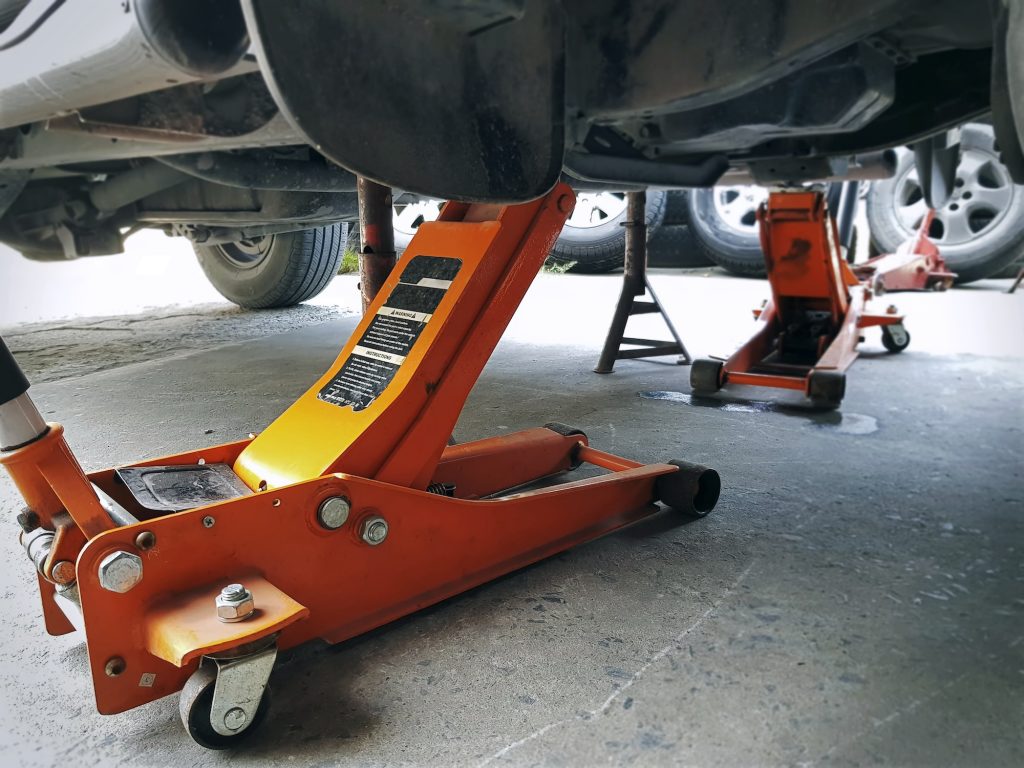
Common uses for a hydraulic jack in DIY maintenance include:
- Lifting the car onto jack stands for suspension work
- Raising and supporting the vehicle when changing tyres
- Elevating a wheel to remove it for repairs or replacement
- Accessing the underside when changing oil, exhaust, or other components
- Mobile car lifting for repairs outside the garage
Bottle jacks, floor jacks, and scissor jacks all have their pros and cons. But some form of hydraulic jack is mandatory for the do-it-yourself mechanic.
Safely Lifting Your Car with a Hydraulic Jack
Here are some tips for safely and effectively using a DIY hydraulic jack:
- Use jack stands – Once raised, support the car on stands rather than relying on the jack alone.
- Follow manufacturer lifting points – Refer to the owner’s manual to avoid damaging the chassis.
- Check for stability – Make sure the jack sits on a flat, solid surface and the car is centered on the saddle.
- No rapid pumping – Gently raise the lifting arm, never quickly. Listen for any creaks or bending metal.
- Watch for shifting – If the vehicle slips or settles, stop and identify the problem before continuing.
- Wheel chocks – Chock drive wheels when changing a tyre or lifting one wheel.
- Use the handle – Lower the lifting arm slowly using the release valve. Don’t rely on mechanical lowering.
Equipped with the proper knowledge, a hydraulic jack can safely make many repairs possible that otherwise couldn’t be performed without a full garage lift. It’s the cornerstone of any home auto shop.
Essential Power Tool #9: Torque Wrench
Some car components like cylinder heads, connecting rods, and wheel lugs require tightening hardware to a precise torque specification. A torque wrench allows accurately achieving the needed tightness.
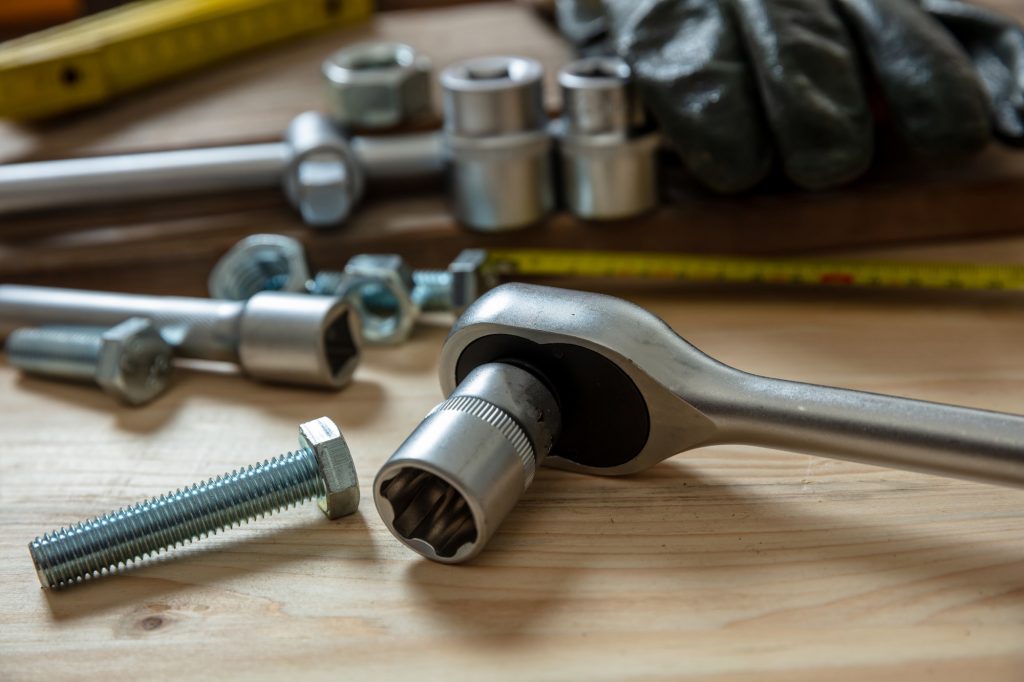
Common automotive uses for a torque wrench include:
- Tightening wheel lug nuts to the manufacturer’s torque spec
- Achieving proper torque on engine bolts during reassembly
- Precisely torquing suspension components during alignment
- Setting torque specifications on transmission assembly bolts
The incremental and audible click design allows “feeling” when the pre-set torque level is achieved, preventing overtightening.
Ensuring Proper Tightness with a Torque Wrench
Here are some key benefits provided by a torque wrench during car repairs and maintenance:
- Prevents damage – Achieving proper torque keeps you from stripping or breaking bolts and parts.
- Avoids loose components – Following torque specs keeps parts from working loose over time and failing.
- Accuracy – Dialing in and hitting the right torque spec is impossible to reliably guess without a torque wrench.
- Protects investment – Use torque specs needed to maintain warranties and prevent premature failures.
- Safety – Components like wheels loosen over time without proper torque. A wrench prevents this road hazard.
- Confidence – You can be confident parts are assembled to the manufacturer’s specifications when using a torque wrench.
While an often-overlooked tool, a quality torque wrench is a must-have for correctly tightening hardware on critical components. Using torque specs is a hallmark of professional technicians.
Essential Power Tool #10: Jumper Cables
Even with diligent battery maintenance, a dead battery can still leave you stranded. Jumper cables allow restarting your car by connecting to a running vehicle with a good battery to provide starting power.
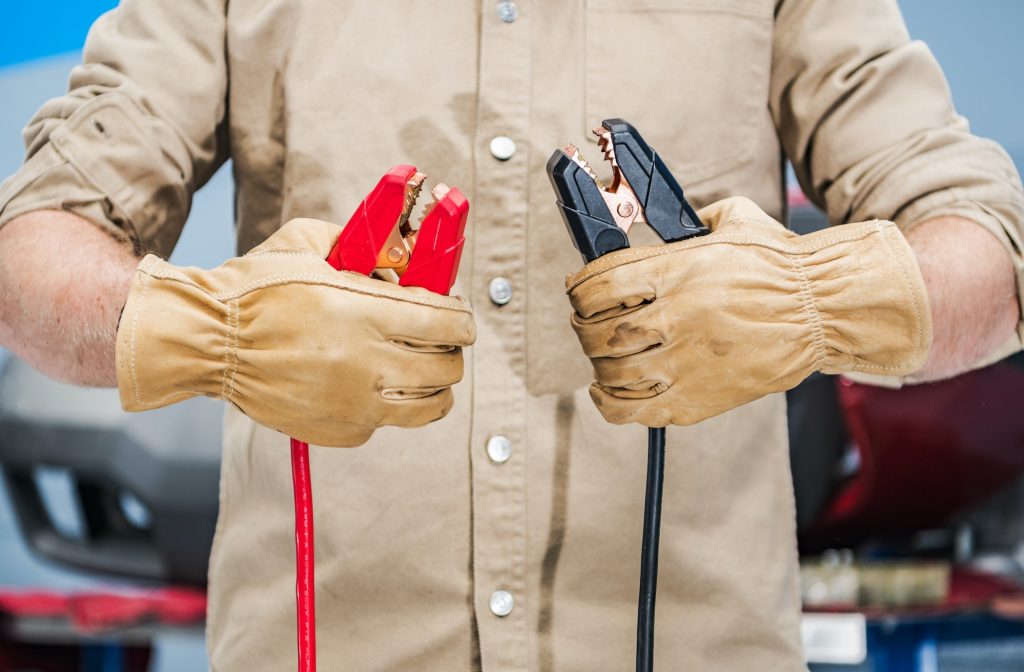
Jumper cables see frequent use for:
- Jump starting a vehicle with a rundown or dead battery
- Providing power if the charging system fails
- Giving a weak battery the extra cranking power needed on cold mornings
- Keeping the battery charged in a stored vehicle during long-term non-use
Heavy-duty jumper cables can even restart larger engines like diesel trucks with their high electrical demands.
Getting Back on the Road with Jumper Cables
A set of jumper cables is essential emergency roadside equipment because:
- Convenience – No need to wave down another driver or call for assistance. You have jump starting capability wherever you go.
- Quick restarting – Get your car or someone else’s going in just a few minutes to minimize downtime.
- Prevent stranding – Never get stuck somewhere due to minor electrical issues.
- Emergency starts – Assist other drivers and get help yourself if your battery dies away from home.
- Compact storage – Jumper cables take up minimal space in the trunk or under a seat.
- Affordability – Quality jumper cables are available in varying lengths at reasonable prices.
Jumper cables belong in any driver’s roadside kit. They can get you out of a jam and keep you from missing appointments or being stranded away from home.
Essential Power Tool #11: Multimeter
An automotive multimeter allows diagnosing and testing electrical circuits and components. This capability aids troubleshooting issues like faulty sensors, lighting problems, and charging system faults.
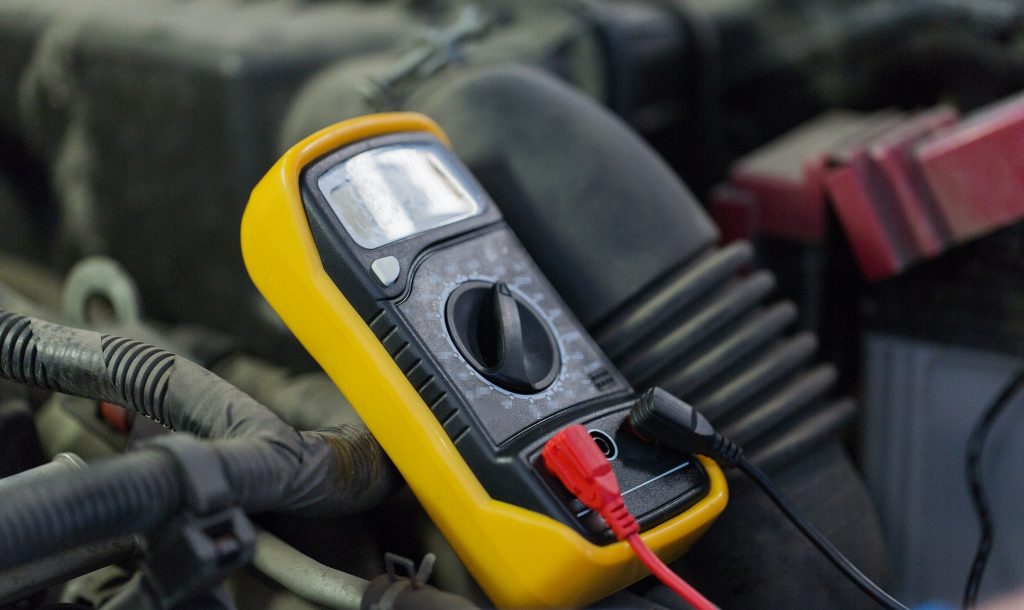
Common diagnostic uses for a multimeter include:
- Checking sensor output voltages and resistance
- Testing current draw on individual fuses and circuits
- Verifying battery charge state and health
- Confirming proper alternator output
- Diagnosing opens, shorts, and high resistance problems in wiring
- Checking continuity of circuits
Advanced multimeters even allow monitoring data streams, recording test results over time, and analyzing results on PC.
Diagnosing Car Problems with a Multimeter
A quality multimeter provides DIYers with vital electrical troubleshooting capabilities:
- Pinpoint issues – Take measurements at different points to isolate faults in a circuit.
- Detect intermittent faults – Logging capabilities can identify occasional electrical glitches that evade detection otherwise.
- Save money – Confirm failed parts instead of replacing good ones during diagnosis.
- In-depth knowledge – Understand your car’s electrical system better by directly observing signals and behavior.
- Self reliance – Troubleshoot problems yourself rather than going to the mechanic.
- Safety – Check for dangerous shorts and voltage leaks.
- Accuracy – Digital multimeters provide precise, reliable measurements versus analog gauges.
While not needed for basic maintenance, a multimeter should be part of any DIYer’s toolbox. The electrical diagnostic capabilities empower troubleshooting many modem car issues.
Essential Power Tool #12: Socket Set
From oil drain plugs to suspension bolts to wheel lugs, almost any repair requires removing and installing threaded fasteners. A quality socket set with various drives and fittings tackles this fundamental task.
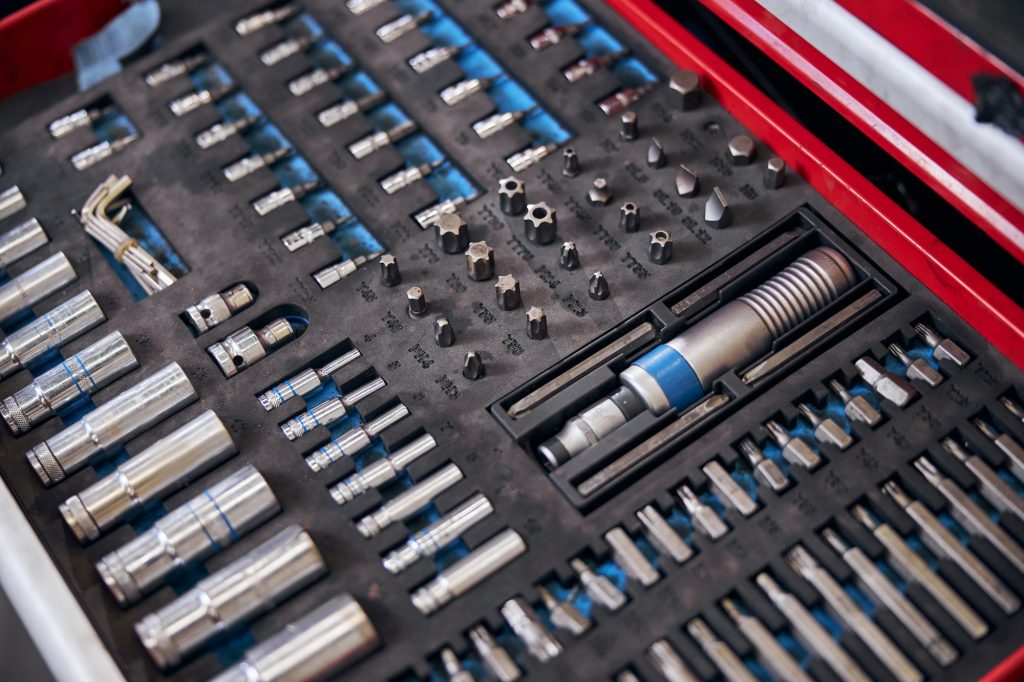
Typical automotive uses for a socket set include:
- Removing engine accessory belts
- Draining engine, transmission, brake, and hydraulic fluids
- Replacing oxygen sensors and emissions components
- Detaching brake calipers, struts, and drivetrain mounts
- Loosening nuts on clamps, fuel lines, and wiring connectors
Multiple ratchet drives like 1/4″, 3/8″, and 1/2″ allow accessing different fasteners and producing adequate torque.
The Versatility of a Socket Set in Car Repairs
Here are some benefits a comprehensive socket set provides for DIY work:
- Access fasteners – The array of sizes fits every bolt, nut, and drain plug. No stripped or rounded off hardware.
- Save time – Correct sockets allow fast removal without struggling with wrenches or pliers.
- Prevent damage – Properly fitting sockets decreases the chance of slippage and stripped or broken bolts.
- Generate torque – Long breaker bars, ratchets, extensions, and adapters allow generating ample force for stubborn hardware.
- Durability – Industrial-grade sockets stand up to years of use without wearing out or breaking.
- Portability – Socket sets organize all these pieces neatly in a compact case.
The socket set often ends up being the most frequently used tool during repairs. Investing in a professional-level kit pays dividends over a lifetime of projects.
Essential Power Tool #13: Screwdriver Set
From delicate electronics to plate panels, a variety of screwdriver sizes and drives are indispensable for car repairs. A comprehensive set tackles all types of screws.
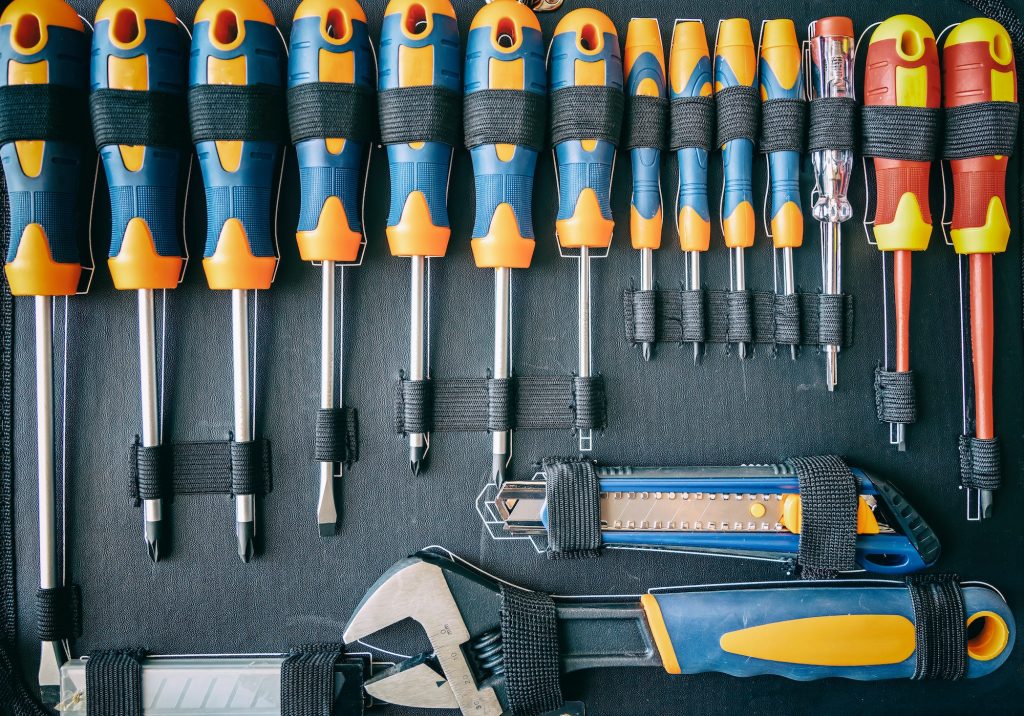
Some automotive uses for the screwdrivers in a set include:
- Slotted – Most body panels, batteries, and metal trim pieces
- Phillips – Sensors, relays, switches, distributors, and various brackets
- Torx – Control units, valve covers, intake components
- Hex – Water pumps, alternator pulley bolts, differential covers
- Pozidriv – Side markers, shift linkage, radio trim pieces
- Tri-Wing – Electronics like parking assist modules
Sturdy magnetic tips provide a secure grip on screws in hard to reach spots.
Why a Screwdriver Set is Essential for DIY Car Maintenance
A comprehensive screwdriver set belongs in every mechanic’s tool kit because:
- Removes fasteners – Different drives allow removing any screw or bolt head encountered.
- Avoids damage – The right size and tip prevents torn hardware and stripped/rounded out fasteners.
- Reaches tight spots – Various handle styles and lengths access screws in awkward, confined areas.
- Facilitates repairs – Disassembling components is impossible without removing all the screws.
- Electronics work – Precision screwdrivers prevent damage to sensitive electronic components.
- Affordability – Even an expansive set covering all drivetypes is reasonably priced for the usefulness.
So whether you’re taking off door panels or digging into transmission internals, keeping a quality screwdriver set close at hand for any fastener challenge is wise.
Essential Power Tool #14: Pliers Set
The versatility of pliers makes them invaluable in situations where fingers just aren’t enough. Different pliers excel at bending, cutting, gripping, forming, and clamping.
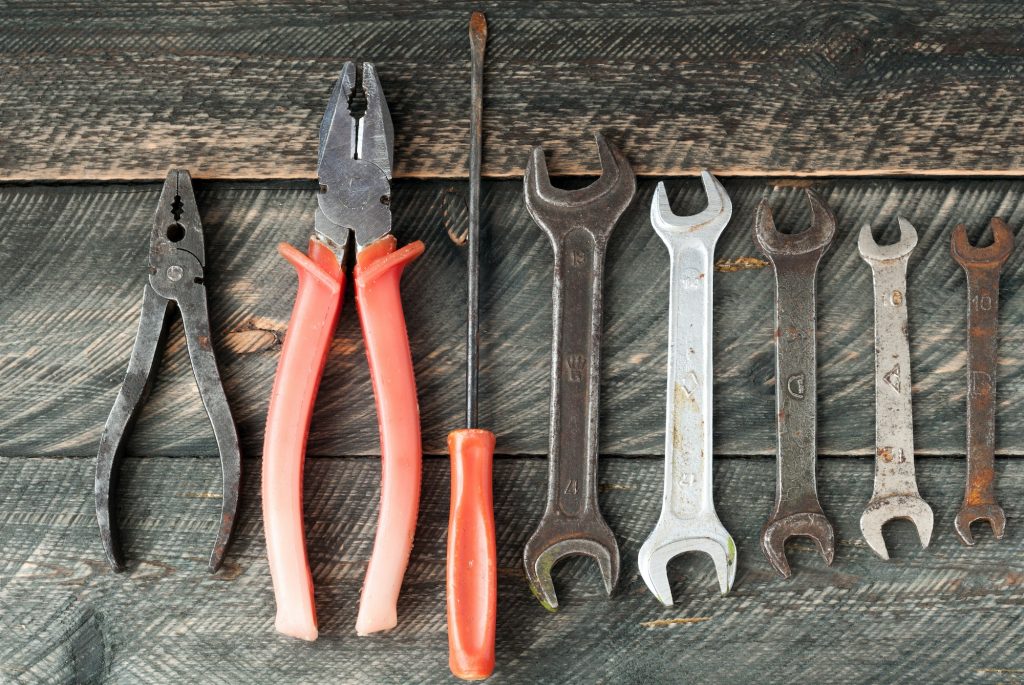
Common automotive uses for various pliers include:
- Slip joint – Adjusting and removing clamps, cotter pins, fittings
- Needle nose – Gripping clips, pulling back lock tabs, grabbing dropped objects
- Locking – Snagging rounded off filter caps that are hard to grip
- Linesman’s – Crimping electrical connectors and cutting small wires
- Circlip – Installing and removing snap rings from shafts and bores
- Wire stripping – Removing plastic coating from wires
Durable, insulated grips provide sure hands-on control even on small, slippery components.
The Many Uses of Pliers in Car Repairs
Here are some key benefits provided by a set of assorted automotive pliers:
- Dexterity – Grips objects too large, heavy, hot, or awkward for fingers alone. Provides mechanical advantage.
- Reaches tight spots – Needle nose and bent variations access confined areas.
- Holds shapes – Use to bend cotter pins, small metal tabs, and wire.
- Cuts wire – Cleaner cuts than scissors or knife when trimming wire ends or electrical connectors.
- Pulls connectors – Use grooves in slip joint pliers to securely grip and pull electrical connectors.
- Durability – Industrial grade pliers stand up to years of use without bending or losing grip strength.
For any task requiring grasping, pulling, bending, shaping, or cutting, the right pliers for the job make the work easier. Pliers are among the most versatile must-have tools.
Essential Power Tool #15: Wire Stripper
Splicing wires, replacing connectors, or hooking up electronics requires stripping insulation from wire ends. Wire strippers neatly handle this tedious chore.
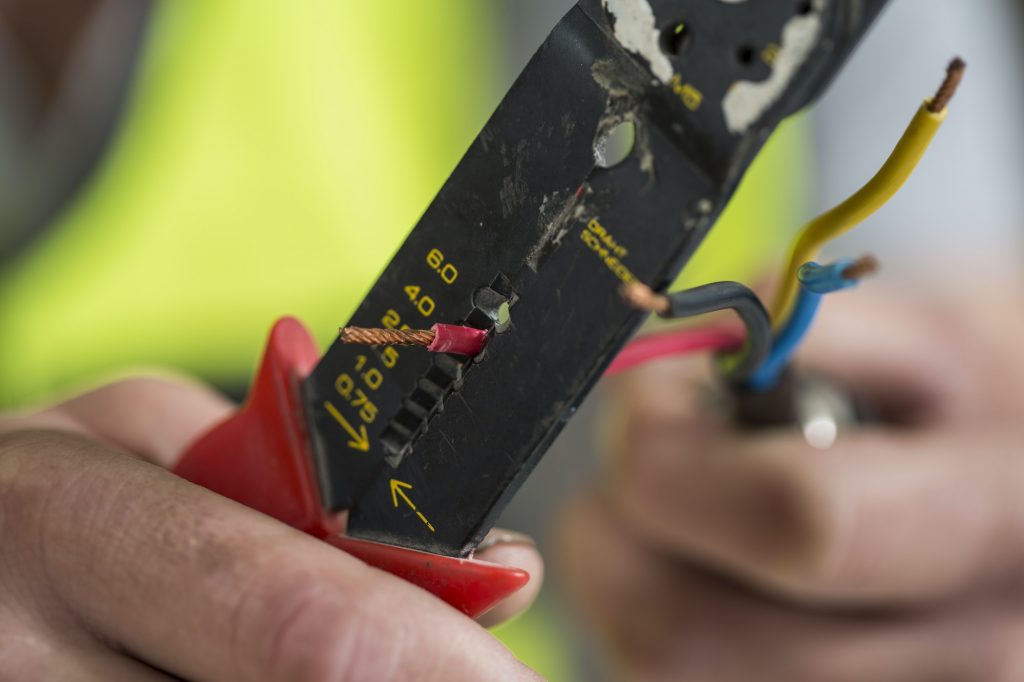
Common uses for wire strippers during automotive work include:
- Stripping wire ends to install terminals and splice connections
- Removing insulation from harness wires for soldering and testing
- Cutting small gauge wire for signal and sensor circuits
- Processing thicker power wires for audio amplifiers and accessories
- Prepping trailer wiring before crimping on connectors
- Trimming zip ties flush during harness installation
Multi-size wire strippers work with gauges from small alarm wires up to primary battery cables.
Working with Electrical Wires Using a Wire Stripper
Here are benefits provided by using quality wire strippers versus hand tools like knives:
- Prevents damage – Removes only insulation without nicking or cutting wire strands.
- Right amount exposed – Exposes just enough wire to make solid terminations.
- Quick operation – Far faster than carefully whittling off insulation with a knife.
- Consistent results – Uniform stripping quality doesn’t rely on hand dexterity or eyesight.
- Flexible sizes – Multi-hole strippers work with wires from tiny electronics to fat power cables.
- Safety – Blades designed not to contact hands plus insulated grips prevent shocks.
- Low cost – Decent quality strippers are available very inexpensively, especially considering their usefulness.
Even DIYers with lots of electrical experience find quality wire strippers indispensable. They prevent wasted hours trying to neatly hand strip wires of all sizes.
Essential Power Tool #16: Breaker Bar
Breaker bars provide the leverage needed to loosen extremely stubborn, overtightened bolts and fasteners that even large ratchets cannot budge. Their long handles generate tremendous force.

Common automotive uses for a breaker bar include:
- Removing seized fasteners like suspension components rusted in place
- Freeing stuck lug nuts and wheel bolts that swollen threads bind in place
- Breaking loose the flywheel bolt for manual transmission work
- Providing additional leverage with cheater pipes for incredible force
- Removing crank bolts and other hardware torqued on excessively tight from the factory
The extra foot or more of leverage aids tremendously in overcoming frozen or overtightened fasteners.
Loosening Stubborn Bolts with a Breaker Bar
Here are advantages provided by a breaker bar during car repairs:
- Frees stuck bolts – Generating far more torque than even a long ratchet handle for stuck, rusty hardware.
- Prevents rounding – The extreme leverage lets fasteners that would otherwise round off break free.
- Saves knuckles – The long handle keeps hands away from scrapes and skinned knuckles common fighting stuck bolts.
- Adds torque – Use with a socket wrench handle or cheater pipe for even more leverage.
- Durability – Industrial grade solid steel bars withstand tremendous forces without bending or breaking.
- Compact storage – Breaker bars stow conveniently until those occasional difficult jobs arise.
When that one stubborn oil pan bolt refuses to budge, a breaker bar provides the muscle and leverage needed to finally break it free. An automotive toolkit staple.
Essential Power Tool #17: Oil Filter Wrench
Changing your own oil is one of the most basic maintenance tasks, but it requires getting the old oil filter off. Oil filter wrenches provide the grip and leverage needed to remove filters easily.
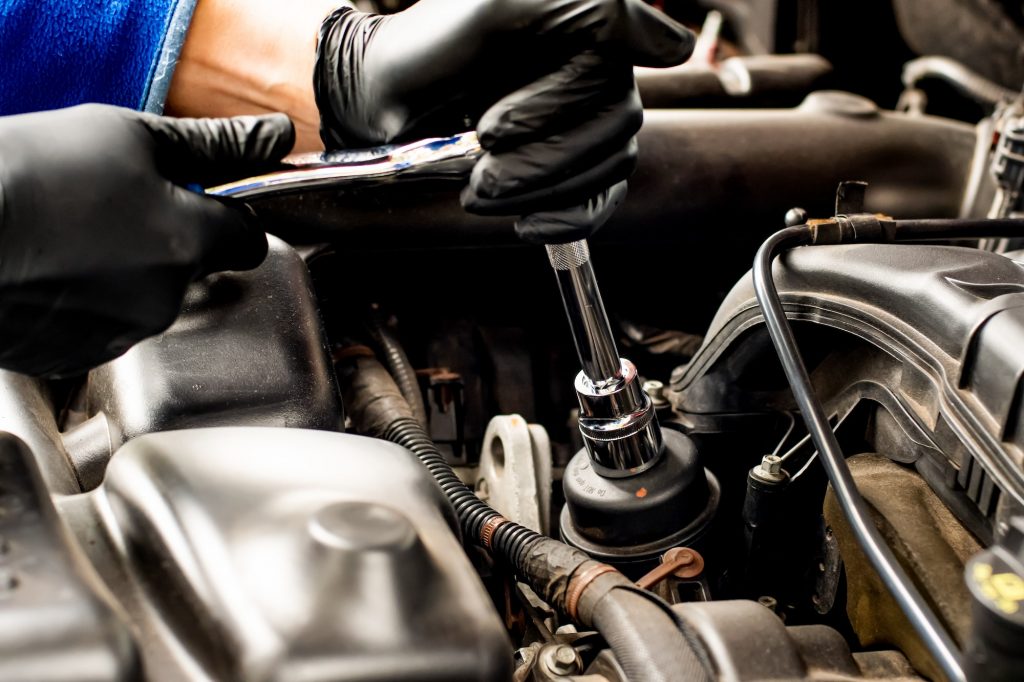
Here are some reasons an oil filter wrench is invaluable during oil changes:
- Holds slippery filters – Gets a firm grip unlike slippery hands that can accidentally crush the filter.
- Adds leverage – Short handles allow getting fingers out of the way while loosening the filter.
- Prevents damage – Shields surrounding metal from dents or scratches during removal.
- Provides confidence – Once gripped in the wrench, the filter will come off without worries about it slipping.
- Durability – Heavy duty steel construction withstands years of repetitive use.
- Low cost – Such an inexpensive tool pays for itself quickly in facilitated oil changes.
Though simple in concept, a dedicated oil filter wrench makes removal and installation quick, clean, and frustration-free. A small price to pay for smooth oil changes.
Essential Power Tool #18: Funnel Set
Refilling automotive fluids from unwieldy bottles and jugs quickly becomes a messy nightmare without a good funnel. Funnels provide clean, fast refilling with no spills or waste.
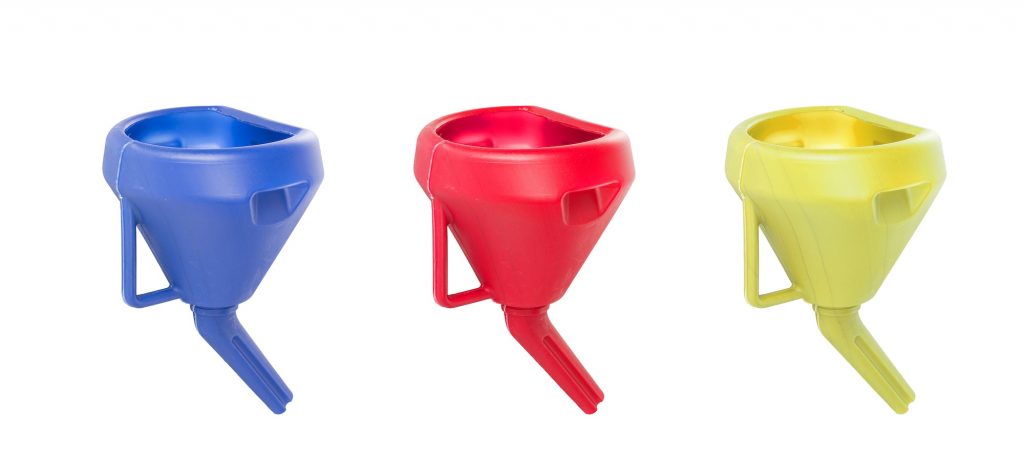
Funnels are indispensible when:
- Adding new engine oil and changing filters
- Topping off brake fluid reservoir
- Refilling power steering fluid
- Replenishing transmission and gearbox oil
- Pouring fresh coolant/antifreeze into the radiator
- Adding windshield washer fluid
Flex spout funnels conform to hard to reach reservoirs and openings.
Avoiding Spills During Fluid Changes with a Funnel Set
Here are benefits provided by a set of automotive funnels:
- Clean filling – Fluids go straight into the opening rather than spilling across the engine.
- Faster refills – No waiting for a trickle or pausing to reposition bottles.
- Prevents overfills – Funnels allow monitoring fill levels to stop at the proper amount.
- Extended spouts – Hard to reach and see filler holes are easily accessed.
- Adaptable – Different funnel sizes for various openings and fluid viscosities.
- Compact storage – Inexpensive funnels stow away until needed.
Even DIYers with lots of experience find funnels a welcome convenience. They speed up fluid changes while also keeping your engine bay clean.
Essential Power Tool #19: Tyre Pressure Gauge
Properly inflated tyres are vital for safety, handling, fuel economy, and tyre life. An accurate tyre gauge allows keeping pressures at optimum levels.
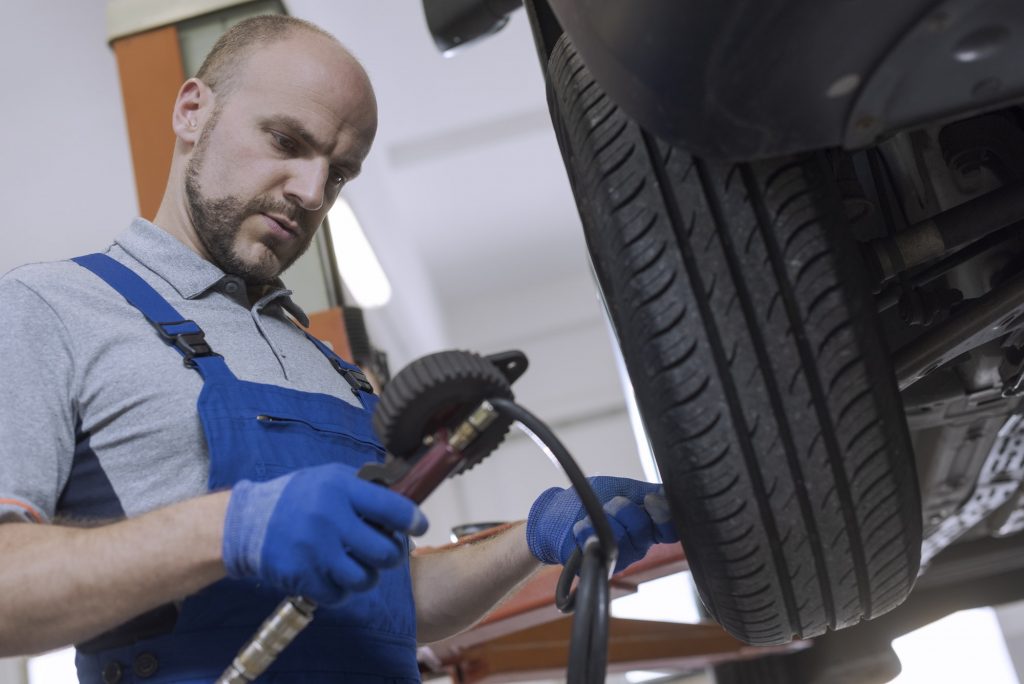
Reasons a tyre gauge is essential:
- Checking inflation against manufacturer recommended pressures
- Identifying underinflated tyres causing poor handling
- Catching air leaks from nails, wear, or defective valves
- Monitoring tyre health and proper inflation over time
- Adapting pressures for load weight and driving conditions
- Preventing overinflation and uneven wear from overfilling
Advanced gauges even allow preset pressures tailored to individual vehicles and tyre sets.
Maintaining Optimal Tyre Pressure with a Tyre Pressure Gauge
Here are benefits of using your own tyre pressure gauge:
- Accuracy – Unlike cursory visual checks, provides precise inflation pressures.
- Identifies issues – Catches underinflation threatening blowouts or overinflation reducing handling.
- Convenience – Check and fill pressures in your garage rather than searching for an air pump.
- Adapts to needs – Dial in ideal pressures for load rather than just filling somewhat close to a sticker.
- Versatility – Use on cars, trucks, trailers, bicycles, wheelbarrows – anything with pneumatic tyres.
- Low cost – An inexpensive tool that pays for itself in tyre life and safety.
The tyre gauge deserves a spot in any auto toolkit. Perfect inflation maximizes performance, life, and safety.
Essential Power Tool #20: OBD2 Scanner
Unlike older cars, 1996+ vehicles continually monitor themselves through on-board diagnostics. An OBD2 scanner plugs in and reads diagnostic trouble codes pointing to issues.
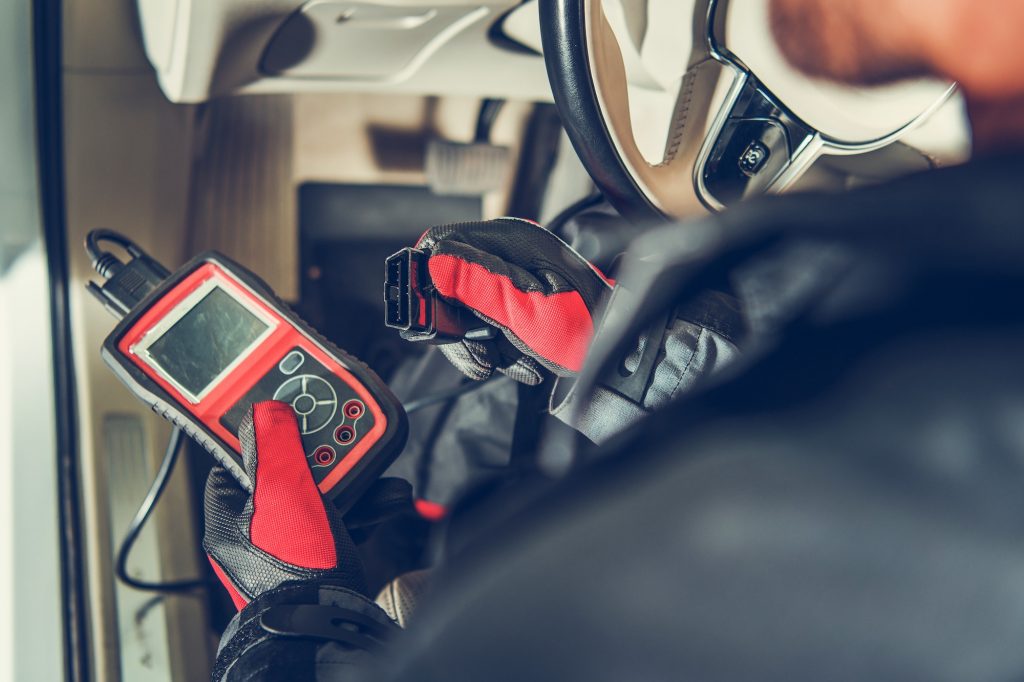
Typical uses for an OBD2 scanner include:
- Pulling check engine light codes to reveal failing parts
- Checking emissions monitor status for inspection readiness
- Viewing live data like temperatures, sensor outputs, engine RPM
- Resetting error codes after repairs to turn off check engine light
- Logging data over time to identify intermittent issues
Advanced models even allow reprogramming modules and performing complex component adaptations.
Diagnosing Car Problems with an OBD2 Scanner
Here are key benefits provided by an OBD2 scanner for DIY use:
- Determines failures – Read error codes without guessing at causes of drivability, performance, or emissions issues.
- Saves money – Pinpoint repairs instead of replacing good parts trying to fix things blindly.
- Quick diagnosis – Scan for codes yourself instead of paying for diagnostic time at the shop.
- See system status – Monitor inputs and outputs to identify marginal components before failure.
- Locate intermittent faults – Log data to catch issues that don’t trigger a code right away.
- Reset maintenance lights – DIY repairs often require resetting dash indicator lights.
While not the first tool a new DIYer needs, an OBD scanner should be added as experience grows. Diagnosing modern vehicle issues requires tapping into OBD2 systems.
The Benefits of Hiring Power Tools for Car Maintenance
The specialized power tools required for car repairs represent a significant upfront investment. However, hiring tools provides an affordable and convenient alternative to purchasing.
Renting power tools from equipment hire companies when the need arises allows DIYers to:
- Avoid large purchases – Pay only for the short periods when you actually need the tools.
- Access specialty tools – Use equipment like scan tools too expensive for casual DIY use.
- Try before buying – Test tools to determine if purchasing your own makes sense for your needs.
- Meet storage needs – No need to find space to store seldom-used equipment.
- Gain experience – Learn proper tool use and techniques without buying immediately.
Hiring also brings advantages like professional advice, maintenance and service, and insurance against damage. Weigh these benefits against purchase costs when considering buying versus renting car power tools.
Introducing Our Recommended Tool Hire Company
With decades of experience serving both DIYers and professional mechanics, National Tool Hire provides top quality equipment along with expert support.
Founded in 1975, National Tool Hire operates from over 75 locations nationwide. The convenient sites allow flexible tool pickup and drop off.
The company’s automotive tool selection includes all the essentials like jacks, air tools, diagnostic equipment, welders, generators, lifts, and work lights. Both corded electric and cordless battery tools are available.
Friendly staff assist in selecting the proper tools for each repair job. Advice helps inexperienced DIYers choose equipment matching their skill level and tasks. Rentals provide everything needed for a weekend project or major overhaul.
How to Hire Tools from National Tool Hire
Hiring tools from National Tool Hire follows a simple process:
Select – Tell staff the repairs planned and vehicle involved so they can recommend proper tools. The company’s site also has DIY tips.
Reserve – Call or reserve online to guarantee desired tools are available when needed. Staff will set aside equipment.
Pick Up – Stop by the local branch at the scheduled time. Staff will ensure you receive all necessary accessories.
Use tools – Follow included operating instructions and safety precautions. Contact the branch with any questions.
Return – Drop off tools at the branch when project complete. Let staff know if any problems occurred.
Checkout – Pay rental fees based on the duration equipment was signed out. No late charges as long as tools returned same day as expected.
Through attentive customer service and tool availability, National Tool Hire aims to make equipment rental a smooth, positive experience for DIY mechanics.
The Cost-Effectiveness of Hiring Power Tools
Purchasing automotive power tools represents a major expense, with professional-grade kits easily costing thousands of dollars. While DIYers focus on the repair budget, tool costs also matter.
Short term rental keeps acquisition costs manageable by paying for only the days or weeks tools are actually needed. With weekend rates around $50 for typical DIY rental kits, this avoids major outlays.
Plus rentals include maintenance and repairs for equipment failures at no cost. Damaged or faulty tools are replaced free of charge. Hiring shifts tool maintenance and service responsibilities to the rental company.
Renting makes the most economic sense for DIYers who work on their own vehicles only intermittently. Even long repairs are affordable paying daily rates over multiple weeks or months. Without acquisition costs, projects stay under budget.
The Convenience of Hiring Tools for DIY Car Maintenance
Beyond cost savings, equipment rental offers advantages of simplicity and flexibility well-suited for DIY mechanics.
Renting eliminates having to research specifications and brands to select power tools optimized for your vehicle. Describe the repairs to rental staff and receive recommendations on the perfect kit for the project.
With no ownership involved, rented tools require no upkeep or maintenance between uses. The rental firm handles all required servicing and repairs before reissuing equipment.
Renting means no tools gathering dust between infrequent repairs. Get precisely the right equipment only when required to complete projects. Avoid cluttering your garage with specialized gear used only once annually.
With such convenience advantages, tool rental streamlines repairs by delivering just the right gear when you need it. No unnecessary costs or equipment.
Safety Considerations When Hiring Power Tools
While rental equipment allows avoiding acquisition expenses, it’s still vital to use hired power tools safely to prevent injuries or damage. Follow this guidance when renting:
- Select equipment matched to your experience level. Don’t take on unfamiliar heavy-duty tools without guidance.
- Review tool operating instructions. Correct PPE and procedures are essential.
- Inspect tools closely for damage before use. Don’t operate faulty equipment.
- Ask questions on proper use before leaving the rental facility. Don’t guess at correct techniques.
- Ensure rental tools include all necessary guards, shields, triggers, clamps, and accessories.
- Handle tools carefully. You are responsible for damage from improper use or negligence.
Ask rental staff for pointers applicable to the specific tools rented. Their expertise helps avoid missteps. With prudent use, hired tools remain safe for DIY work.
The Environmental Benefits of Tool Hire
Beyond cost and convenience, tool rental also benefits the environment compared to each DIYer purchasing equipment. Sharing tools means:
- Fewer total tools produced – No redundant equipment for each user, just enough to meet demand.
- High utilization – Tools are continually used rather than sitting idle in home shops awaiting the next project.
- Better maintenance – Optimal upkeep and servicing makes rental tools last longer.
- Professional transport – Rental shops use efficient logistics versus individuals driving to the store.
- Recycling of damaged tools – Worn equipment gets professionally recycled rather than trashed.
- Less packaging waste – No throwaway packaging required like with retailer tool sales.
Tool sharing exemplifies the “reduce, reuse, recycle” ethos. Rentals positively impact the environment in many ways.
Conclusion: The Empowerment of DIY Car Maintenance
Regular DIY car maintenance provides many rewards beyond saving money on repairs. The self-reliance brings satisfaction and empowerment. Building your automotive knowledge also makes you a smarter buyer and owner.
While the necessary tools represent a hurdle, equipment rental provides affordable access to all the specialized gear required. Hiring tools as needed allows DIYers to take on jobs that might otherwise exceed their budget.
By matching high quality rental equipment with your skills, even major repairs become achievable. The expertise of tool hire staff helps guide novices through daunting projects. Don’t let lack of gear or knowledge prevent you from becoming self-sufficient with your own vehicle maintenance.
With some guidance and the right rented tools, you can handle everything from oil changes to brake overhauls to engine rebuilds yourself. Let tool hiring make DIY car repairs and maintenance more accessible and rewarding.
The Satisfaction of Maintaining Your Own Car
Beyond concrete benefits like saving money, DIY car maintenance brings a great sense of personal satisfaction and enjoyment. Here are some of the intangible rewards:
- Pride – Seeing your clean oil change or new brakes makes you proud of keeping your car in shape yourself.
- Accomplishment – Learning new skills and tackling complex repairs provides challenging wins.
- Confidence – With experience, you gain confidence in diagnosing and fixing your own car problems.
- Knowledge – Understanding your car inside and out feels empowering and comforting.
- Challenge – Approaching repairs as puzzles to solve makes maintenance engaging.
- Progress – Seeing your expertise grow repair after repair builds positive momentum.
- Individuality – The chance to customize your car to your exact preferences.
- Memories – Joy looking back at repairs and upgrades you performed.
For those who love their vehicle, DIY maintenance offers lasting personal satisfaction that paying for repairs can never provide.
The Money-Saving Benefits of DIY Car Maintenance
While the emotional rewards matter most, DIY maintenance also provides major potential cost savings versus paying mechanics.
Labor costs make up the bulk of repair facility charges. DIYers pay only for parts at wholesale rates without high hourly shop fees.
Basic maintenance like oil changes can easily cost $50+ in a shop. The DIYer spends only $20 or so on materials.
More complex jobs like brake pad replacement can run $300+ in labor fees at a garage. With rented tools, a DIY brake job costs around $100 total.
Preventive maintenance helps avoid major failures. Replacing a bad alternator runs well over $500 at a shop but closer to $200 doing it yourself.
Over just a few repairs, DIY maintenance easily saves thousands compared to shop rates. The savings justify acquiring some specialized tools and capabilities.
The Knowledge Gained from DIY Car Maintenance
In addition to saving money, DIY repairs provide the chance to build automotive knowledge through hands-on experience.
With each maintenance task and repair, you gain familiarity with the components involved. Methodically working on systems yourself makes their operation much clearer.
This deeper understanding aids in diagnosing issues when they eventually arise. You’ll know where to start testing and what to look for based on past experience.
Knowledge and observational skills developed through maintenance transfers to smarter inspection when shopping for a used car. You’ll spot issues and assess condition better.
The repair learning journey also makes you a more informed car owner better able to communicate needs to shops when required. Overall, practical knowledge proves invaluable.
The Importance of Regular Car Maintenance
Proper routine maintenance is crucial to ensuring the longevity, safety, and performance of your vehicle. Making minor repairs promptly also prevents major breakdowns.
The basics like oil changes, tyre rotation, fluid flushes and fills, new filters, inspections, belt replacement, and brake service extend your car’s life at minimal cost.
Performing tasks like tightening components, cleaning connections, lubricating parts, and testing electronics during maintenance keeps problems from escalating.
Regular maintenance also gives you familiarity with your vehicle that allows spotting issues like leaks, damaged components, and abnormal wear early.
Don’t just fix things when they break. Making maintenance a habit prevents failures and keeps your car running smoothly for the long haul.
The Role of Power Tools in Simplifying Car Maintenance
Many maintenance tasks become trivial with the aid of power tools specialized for automotive work. They simplify jobs by removing drudgery and physical effort.
Using an impact wrench with the proper socket makes removing even severely overtightened lug nuts a breeze during tyre rotations or wheel service. The power tool prevents fighting stuck fasteners manually.
Similarly, an air ratchet zips off engine belt pulleys in seconds. Hand-turning wrench fights are eliminated. The job becomes almost enjoyable.
Power buffers take the strenuous effort out of polishing a finishes restoring shine. Vacuum extractors mean no more struggling to remove fluid by hand.
Oil filter pliers prevent slippery fingers from crushing filters during changes. Hydraulic jacks lift a vehicle safely without strain. Proper power tools simplify all types of maintenance tasks.
The Ease of Hiring Tools for Car Maintenance
The one hurdle to using specialty power tools is cost. An avid DIYer may justify buying their own kit, but most want to minimize expenses.
Tool hiring provides the perfect solution, offering access to professional automotive tools without investment and storage headaches. Pay only for the days equipment is actually needed.
With the selection expertise of tool hire staff, get help picking just the right gear for any maintenance task or repair. Avoid buying tools you rarely use.
Hiring allows first-time access to advanced tools like alignment racks, diagnostic scanners, and advanced jacks. Explore new capabilities without commitment.
For DIYers performing maintenance intermittently when they have time,Rental equipment provides the most affordable, flexible access to the specialized tools required.
The Future of DIY Car Maintenance
While vehicles become more complex with added electronics and features, DIY maintenance remains viable with some adaptation.
Newer diagnostic tools like code readers allow DIYers to understand check engine lights and performance issues just like professional techs. Take time to learn how vehicle computers and sensors work.
Advanced drivetrains in hybrid and electric vehicles require added precautions and some new procedures. But batteries, brakes, and suspension still use familiar skills.
Online forums connect DIYers to share knowledge on newer models and systems. YouTube also offers a wealth of how-to videos. Leverage these resources when working on unfamiliar vehicle systems.
Mainstream auto parts stores now provide tool rentals for infrequent jobs. And mobile mechanics allow DIYers to tackle tasks requiring a lift. DIY remains viable with some creative adaptation.
The desire for self-reliance will sustain the DIY community. New tools and knowledge sharing empower individuals to maintain even modern complex vehicles themselves.
Final Thoughts: Embrace the DIY Spirit in Car Maintenance
If you feel intimidated tackling your own car repairs and maintenance, understand that learning and experience resolve uncertainty. Arm yourself with quality rented tools to build skills safely.
Patience and research allows puzzling through even major repairs methodically. Rewarding feelings of accomplishment follow.
Don’t let lack of specialized gear stop you. Tool rental provides affordable access to all the equipment needed for professional results.
Approach repairs logically as learning opportunities. Over time, your expertise will grow with each project. Building skills brings confidence and satisfaction.
So embrace DIY car maintenance as a journey of mastery. Let the right tools be your companion. With practical knowledge and some guidance, you can keep your car running smoothly for years to come while saving money. Working on your own car remains one of the most empowering hobbies around.





